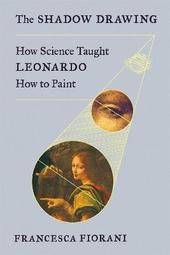
|
The Shadow Drawing: How Science Taught Leonardo How to Paint
Hardback
Main Details
| Title |
The Shadow Drawing: How Science Taught Leonardo How to Paint
|
| Authors and Contributors |
By (author) Francesca Fiorani
|
| Physical Properties |
| Format:Hardback | | Pages:384 | | Dimensions(mm): Height 238,Width 162 |
|
| Category/Genre | Renaissance art
Painting and paintings |
|---|
| ISBN/Barcode |
9780374261962
|
| Classifications | Dewey:759.5 |
|---|
| Audience | |
|---|
| Illustrations |
8 Pages of Color Images; 46 Black-and-White Images in Text / Notes, Index
|
|
Publishing Details |
| Publisher |
Farrar, Straus & Giroux Inc
|
| Imprint |
Farrar, Straus & Giroux Inc
|
| Publication Date |
17 November 2020 |
| Publication Country |
United States
|
Description
Leonardo da Vinci has long been celebrated for his consummate genius. He was the painter who gave us the Mona Lisa and The Last Supper, and the inventor who anticipated the advent of airplanes, hot air balloons, and other technological marvels. But what was the connection between Leonardo the painter and Leonardo the scientist? Historians of Renaissance art have long supposed that Leonardo became increasingly interested in science as he grew older and turned his insatiable curiosity in new directions. They have argued that there are, in effect, two Leonardos-an artist and an inventor. In this pathbreaking new interpretation, the art historian Francesca Fiorani offers a different view. Taking a fresh look at Leonardo's celebrated but challenging notebooks, as well as other sources, Fiorani argues that Leonardo became familiar with advanced thinking about human vision when he was still an apprentice in a Florence studio-and used his understanding of optical science to develop and perfect his painting techniques. For Leonardo, the task of the painter was to capture the interior life of a human subject, to paint the soul. And even at the outset of his career, he believed that mastering the scientific study of light, shadow, and the atmosphere was essential to doing so. Eventually, he set down these ideas in a book-A Treatise on Painting-that he considered his greatest achievement, though it would be disfigured, ignored, and lost in subsequent centuries. Ranging from the teeming streets of Florence to the most delicate brushstrokes on the surface of the Mona Lisa, The Shadow Drawing vividly reconstructs Leonardo's life while teaching us to look anew at his greatest paintings. The result is both stirring biography and a bold reconsideration of how the Renaissance understood science and art-and of what was lost when that understanding was forgotten.
Author Biography
Francesca Fiorani is an associate dean for arts and humanities and professor of art at the University of Virginia. A leading authority on Renaissance art and the application of computer technology to the humanities, she is the creator of the Leonardo da Vinci and His Treatise on Painting digital platform and the author of The Marvel of Maps: Art, Cartography, and Politics in Renaissance Italy.
Reviews[Fiorani] makes [her argument] with fresh force and pitches it against the misconception that Leonardo abandoned painting for science in his later years . . . when she loses herself in looking, the book achieves fluency and power. She notes the traces of the azure paint on the throat of the "Mona Lisa" and wonders if it is responsible for giving us the sense of seeing her pulse. Or take the bravura section on "The Last Supper," in which she explains how the painting exists in two time frames, with several characters making gestures that will mark them in the future. --Parul Sehgal, The New York Times Through a series of close studies of paintings, Ms. Fiorani demonstrates how Leonardo explored light and shadow in a range of challenging subjects. She builds up the reader's knowledge of what can be an abstruse and highly mathematical field through detailed and lively considerations of individual art works. Her study of the unfinished "Adoration of the Magi" (1481), is particularly compelling. --Cammy Brothers, The Wall Street Journal [Francesca Fiorani] provides new insight into the work of Renaissance master Leonardo da Vinci in this fresh assessment . . . This beautifully written work is underpinned by immense scholarship; art lovers and historians will not be able to put it down. --Publishers Weekly University of Virginia art historian Fiorani's sparkling second book explores how Leonardo's love of science informed his art. Intimately capturing the artistic, religious, and cultural landscape of Leonardo's world, the author traces his development as an artist from his early apprenticeship days to the lessons he learned as he painted his greatest works and up to his posthumous legacy . . . Fiorani effectively describes Leonardo's experiments with paints that allowed him to 'achieve an astounding variety of optical effects'. --Kirkus Reviews "In this insightful and beautiful book, the great Leonardo scholar Francesca Fiorani connects his studies of optics with his painting. It's a wonderful study of how Leonardo's art and science were interwoven--which should be an inspiration to us all." --Walter Isaacson, author of Leonardo da Vinci Francesca Fiorani's lively intellectual adventure gives us a new understanding and appreciation of Leonardo's ingenious cross-fertilization of art and science. It is a perceptive biography of Leonardo exploring the frontiers of science, but also a brilliantly informative guide to his paintings--many of which I will now enjoy seeing again with Fiorani's fresh insights in mind." --Ross King, author of Brunelleschi's Dome, Leonardo and the Last Supper, and Mad Enchantment Francesca Fiorani's book makes an effective contribution towards demolishing the false notion of two Leonardos--one the artist, the other the scientist. Fiorani masterfully shows how science enabled the young Leonardo to take Renaissance painting to an unprecedented level of perfection. No matter how many books about Leonardo you might have read, this one is not to be missed. It will shape your understanding of his beautiful mind's all-encompassing vision of art, nature, and man. --Paolo Galluzzi, director, Museo Galileo, Florence
|